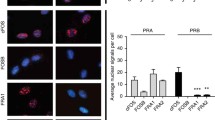Abstract
Progesterone is a key factor in regulating endometrial cell decidualization, but the signal transduction pathways involved in mediating the effects of progesterone are not known. A role of the cAMP pathway in decidualization has been suggested by in vitro studies demonstrating that cAMP agonists can stimulate decidualization, in the absence of sex steroids. In this article, we have used an in vitro culture model of progesterone-dependent decidualization of human endometrial stromal cells to examine whether progesterone-induced decidualization is associated with activation of the cAMP signal transduction pathway in which the prolactin gene expression is a marker of decidualization. Following a lag period of approx 3 d, progesterone induced prolactin secretion and elevated intracellular cAMP levels. By d 15, cAMP and prolactin levels were approx 10- and 60-fold greater, respectively, than those on d 3. Changes in cAMP levels showed a positive correlation with prolactin secretion. Prostaglandin E2 (PGE2), which enhances progesterone-dependent decidualization, also increased both prolactin secretion and cAMP levels approx two- to fourfold on d 15 compared with d 3, whereas PGE2 alone, which does not induce decidualization, did not stimulate prolactin secretion or intracellular cAMP accumulation. Conversely, all-trans retinoic acid, which attenuates progesterone-dependent decidualization, significantly (p<0.05) decreased both prolactin secretion and cAMP levels. Furthermore, the protein kinase A (PKA) inhibitor, 8-bromoadenosine-3′,5′-cyclic monophosphorothioate, significantly (p<0.05) suppressed progesterone-dependent prolactin expression. Since activation of the PGE2 receptor subtype EP2 stimulates adenylate cyclase, reverse transcription-polymerase chain reaction (RT-PCR) analysis of endometrial cells was undertaken. Expression of EP2 mRNA was induced in cells treated with progesterone and estradiol alone or with PGE2, compared with untreated controls. The data suggest that the cAMP signal transduction cascade is activated during progesterone-dependent decidualization.
Similar content being viewed by others
References
Tang, B., Guller, S., and Gurpide, E. (1993).Endocrinology 133, 2197–2203.
Gellersen, B., Kempf, R., Telgmann, R., and DiMattia, G. E. (1994).Mol. Endocrinol. 8, 356–373.
Tanaka, N., Miyazaki, K., Tashiro, H., Mizutani, H., and Okamura, H. (1993).J. Reprod. Fertil. 97, 33–39.
Bergamini, C. M., Pansini, F., Bettocchi, S., Jr., Segala, V., Dallocchio, F., Bagni, B., and Mollica, G. (1985).J. Steroid Biochem. 22, 299–303.
Houserman, V. L., Todd, H. and Hertelendy, F. (1989).J. Reprod. Fert. 85, 195–202.
Coleman, R. A., Smith, W. L., and Narumiya, S. (1994).Pharmacol. Rev. 46, 205–229.
Irwin, J. C., Utian, W. H., and Eckert, R. L. (1991).Endocrinology 129, 2385–2392.
Brar, A. K., Frank, G. R., Richards, R. R., Meyer, A. J., Kessler, C. A., Cedars, M. I., Klein, D. J., and Handwerger, S. (1995).J. Cell. Physiol. 163, 30–37.
Frank, G. R., Brar, A. K., Cedars, M. I., and Handwerger, S. (1993).Endocrinology 134, 258–263.
Brar, A. K., Kessler, C. A., Meyer, A. J., Cedars, M. I., and Jikihara, H. (1996).Mol. Human Reproduction 2, 185–193.
Frank, G. R., Brar, A. K., Jikihara, H., Cedars, M. I., and Handwerger, S. (1995).Biol. Reprod. 52, 184–191.
Zhou, J., Dsupin, B. A., Giudice, L. A., and Bondy, C. A. (1994).J. Clin. Endocrinol. Metab. 79, 1723–1734.
Telgmann, R., Maronde, E., Tasken, K., and Gellersen, B. (1997).Endocrinology 138, 929–937.
Cho, H., Aronica, S. M., and Katzenellenbogen, B. S. (1994).Endocrinology 134, 658–664.
Park-Sarge, O.-K. and Sarge, K. D. (1995).Endocrinology 136, 5430–5437.
Sirotkin, A. V. and Nitray, J. (1993).J. Steroid Biochem. Mol. Biol. 46, 573–577.
Beck, L., Mularoni, A., Cardis, P., Adessi, G. L., and Nicollier, M. (1995).Endocrinology 136, 1737–1743.
Yee, G. M. and Kennedy, T. G. (1991).Biol. Reprod. 45, 163–171.
Fortier, M. A., Boulanger, M., Boulet, A. P., and Lambert, R. D. (1987).Biol. Reprod. 36, 1025–1033.
Regan, J. W., Bailey, T. J., Pepperl, D. J., Pierce, K. L., Bogardus, A. M., Donello, J. E., Fairbairn, C. E., Kedzie, K. M., Woodward, D. F., and Gil, D. W. (1994).Prostaglandins 47, 151–168.
Negishi, M., Sugimoto, Y., and Ichikawa, A. (1995).J. Lipid Mediators Cell Signalling 12, 379–391.
Kennedy, T. G., Martel, D., and Psychoyos, A. (1983).Biol. Reprod. 29, 556–564.
de Bustros, A., Ball, D. W., Peters, R., Compton, D., and Nelkin, B. D. (1992).Biochem. Biophys. Res. Commun. 189, 1157–1164.
Vallejo, M. (1994).J. Neuroendocrinol. 6, 587–596.
Muro, A. F., Bernath, V. A., and Kornblihtt, A. R. (1992).J. Biol. Chem. 267, 12,767–12,774.
Kinane, T. B., Shang, C., Finder, J. D., and Ercolani, L. (1993).J. Biol. Chem. 268, 24,669–24,676.
Andersen, B., Kennedy, G. C., Hamernik, D. L., Bokar, J. A., Bohinski, R., and Nilson, J. H. (1990).Mol. Endocrinol. 4, 573–582.
Boularand, S., Darmon, M. C., Ravassard, P., and Mallet, J. (1995).J. Biol. Chem. 270, 3757–3764.
Markoff, E., Zeitler, P., Peleg, S., and Handwerger S. (1983).J. Clin. Endocrinol. Metab. 56, 962–968.
Irwin, J. C., Kirk, D., King, R. J., Quigley, M. M. and Gwatkin, R. B. (1989).Fertil. Steril. 52, 761–768.
Golander, A., Hurley, T., and Handwerger, S. (1979).J. Endocrinol. 82, 263–267.
Chomczynski, P. and Sacchi, N. (1987).Anal. Biochem. 162, 156–159.
Author information
Authors and Affiliations
Corresponding author
Rights and permissions
About this article
Cite this article
Brar, A.K., Frank, G.R., Kessler, C.A. et al. Progesterone-dependent decidualization of the human endometrium is mediated by cAMP. Endocr 6, 301–307 (1997). https://doi.org/10.1007/BF02820507
Received:
Revised:
Accepted:
Issue Date:
DOI: https://doi.org/10.1007/BF02820507



